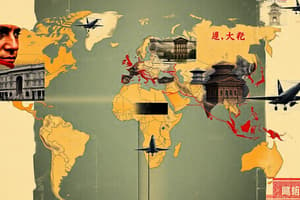Podcast
Questions and Answers
What was one of the most common products for trading along the Silk roads?
What was one of the most common products for trading along the Silk roads?
- Tea
- Silk (correct)
- Gold
- Spices
Why were many middlemen involved in the trading process along the Silk roads?
Why were many middlemen involved in the trading process along the Silk roads?
- To increase the value of the exports
- To facilitate cultural exchange
- To get the goods to their destination (correct)
- To ensure the safety of the goods
What key role did the Silk roads play in global trade?
What key role did the Silk roads play in global trade?
- Promoting isolationism
- Encouraging self-sufficiency
- Preventing cultural diffusion
- Facilitating people's movements and trans-border relations (correct)
In the 16th century, what did Europeans do to expand their influence globally?
In the 16th century, what did Europeans do to expand their influence globally?
What type of goods were Europeans particularly interested in trading during their expeditions in the 16th century?
What type of goods were Europeans particularly interested in trading during their expeditions in the 16th century?
What was considered a luxury good along the Silk roads, besides silk?
What was considered a luxury good along the Silk roads, besides silk?
During the first wave of globalization in the 19th century, what marked the period?
During the first wave of globalization in the 19th century, what marked the period?
What advantage was gained during the first wave of globalization related to power sources?
What advantage was gained during the first wave of globalization related to power sources?
What negative impact did technical change bring during the first wave of globalization?
What negative impact did technical change bring during the first wave of globalization?
What characterized the First Industrial Revolution during the first wave of globalization?
What characterized the First Industrial Revolution during the first wave of globalization?
What was a disadvantage faced during the first wave of globalization regarding worker's housing conditions?
What was a disadvantage faced during the first wave of globalization regarding worker's housing conditions?
In which wave of globalization was the cyber world considered a significant factor?
In which wave of globalization was the cyber world considered a significant factor?
Flashcards are hidden until you start studying
Study Notes
Ancient Silk Roads
- Silk roads are ancient network of trade routes connecting East and West, facilitating goods and services exchange.
- Silk, a luxury good, was a common product for trading, obtained from silkworms and woven into textiles.
- Spices were also popular goods for trading, adding to intercontinental trade between Asia and Europe.
- Global trade links were established, opening doors for trans-border relations among countries.
16th Century
- Europeans established trade connections, settling vast areas, and defining interactions between people.
- Colonization took place worldwide, with sponsored expeditions by European countries in search of spices.
First Wave of Globalization (19th century)
- This period marked intense globalization, with massive migrations, expanded trade, and new norms governing international conduct.
- It was the era of the First Industrial Revolution, with cities growing as people shifted from farming to industry and commerce.
- Advantages of this period include:
- Invention of machines for spinning and weaving cloth.
- Widespread use of the steam engine as a power source.
- Use of coal in smelting and refining iron.
- Construction of railways.
- Disadvantages of this period include:
- Technical change causing job losses.
- Cities experiencing pollution.
- Limited education provision.
- Poor worker housing conditions.
Globalization 4.0 (20th Century)
- Considered the golden age of globalization, with free and significant movement of people, goods, and services across national borders.
- The cyber world marks the new partition of globalization.
Studying That Suits You
Use AI to generate personalized quizzes and flashcards to suit your learning preferences.




